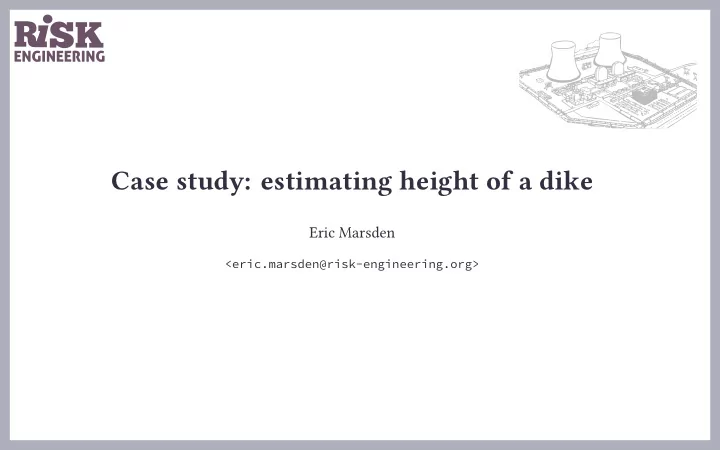

Case study: estimating height of a dike Eric Marsden <eric.marsden@risk-engineering.org>
2 / 15 Source: flickr.com/photos/william_veerbeek/7703915786/ , CC BY-NC-SA licence Dikes and fmooding
3 / 15 Flood protection equipment in New Orleans afuer passage of hurricane Katrina Dikes and fmooding
4 / 15 Source: flickr.com/photos/tomlawrence/621868082 , CC BY-NC-SA licence Dikes and fmooding
5 / 15 Illustration of dike failure
• dike geometries and materials • hydrological, hydraulic and topographic data • wind speed and directions • linked wave efgects • changing roughness due to seasonal vegetation • efgect of sediment transport on fmow resistance • main aim is to illustrate difgerent risk assessment approaches 6 / 15 Modelling fmood risk ▷ In reality, dike design is a function of many parameters: ▷ In this work, very simplifjed equations are used
7 / 15 Source: B. Iooss, P. Lemaître, A review on global sensitivity analysis methods , 2015, hal-00975701 Model parameters
8 / 15 ⎞ where uncertainty 3/5 ⎠ ⎟ ⎟ ⎟ ⎟ ⎟ The maximal water level of the river ( 𝑎 𝑑 ) is given as a function of several ⎟ ⎛ parameters, some of which are uncertain: ⎝ ⎜ ⎜ ⎜ ⎜ ⎜ ⎜ 𝑅 The system model 𝑎 𝑑 = 𝐿 𝑡 × 𝐶 × √( 𝑎 𝑛 − 𝑎 𝑤 )/𝑀 ▷ 𝑎 𝑑 is fmood level (variable of interest) ▷ 𝑎 𝑛 and 𝑎 𝑤 are level of the riverbed, upstream and downstream (uncertain) ▷ 𝑅 is maximal annual fmowrate of the river (uncertain) ▷ 𝐿 𝑡 is Strickler’s roughness coeffjcient (uncertain) ▷ 𝐶 and 𝑀 are the width and length of the river cross section (certain)
9 / 15 Triangular 𝒰(49, 50, 51) 300 m River width 𝐶 5000 m Length of the river stretch 𝑀 Triangular 𝒰(54, 55, 56) m River upstream level 𝑎 𝑛 m Input River downstream level 𝑎 𝑤 Truncated normal 𝒪(30, 8) on [15, +∞[ - Strickler coeffjcient 𝐿 𝑡 Fit to observations m³/s Maximal annual fmowrate 𝑅 Probability distribution Unit Description Input parameters
You have the following measurements of the maximum fmowrate in the river from the past 20 years (observations are expressed in m³/s): 1114, 773, 570, 1069, 1340, 2653, 2956, 892, 701, 1169, 525, 683, 2102, 1060, 296, 2107, 1720, 849, 1361, 2024 10 / 15 Flowrate measurements
model inputs 𝑅, 𝑎 𝑛 , 𝑎 𝑤 , 𝐿 𝑡 system model model output 𝑎 𝑑 11 / 15 System model and risk 𝑎 𝑑 = 𝑔 (𝑅, 𝑎 𝑛 , 𝑎 𝑤 , 𝐿 𝑡 ) choose 𝐼 𝑒𝑗𝑙𝑓 given 𝑎 𝑑
12 / 15 𝑛 point estimate point estimates 𝑑 𝑎 ∗ 𝑡 system model 𝐿 ∗ 𝑎 ∗ 𝑤 𝑎 ∗ 𝑛 𝑎 ∗ 𝑅 ∗ Deterministic approach to risk assessment 𝑎 𝑑 = 𝑔 (𝑅, 𝑎 𝑛 , 𝑎 𝑤 , 𝐿 𝑡 ) H dike Z c * << H dike safety margin Z c *
system model Monte Carlo methods 𝑅 𝑎 𝑛 𝑎 𝑤 𝑎 𝑛 𝐿 𝑡 𝑎 𝑑 13 / 15 Probabilistic approach to risk assessment 𝑎 𝑑 = 𝑔 (𝑅, 𝑎 𝑛 , 𝑎 𝑤 , 𝐿 𝑡 )
13 / 15 𝑎 𝑤 𝑎 𝑑 system model 𝑎 𝑛 𝐿 𝑡 𝑎 𝑛 𝑅 Monte Carlo methods Probabilistic approach to risk assessment 𝑎 𝑑 = 𝑔 (𝑅, 𝑎 𝑛 , 𝑎 𝑤 , 𝐿 𝑡 ) f Zc ( Z c ) risk! Z c * Z c H dike
• check that a lognormal distribution fjts this data well, using a quantile-quantile plot calculation • use median values for each uncertain parameter using a Monte Carlo approach • note: specialists use the term “0.01 annual exceedance probability” fmood, meaning a fmood that has a 1% chance of happening in any given year 14 / 15 Task ▷ Fit a lognormal distribution to the measurements of maximal fmowrate ▷ Calculate the average height of the river by making a deterministic ▷ Produce a histogram of possible water levels, given the input uncertainty, ▷ Estimate the 100-year fmood level for this river
shape, loc, scale = scipy.stats.lognorm.fit(observations) scipy.stats.probplot(obs, dist=scipy.stats.lognorm(shape,loc,scale), plot=plt.figure().add_subplot(111)) numpy.random.triangular(min, centre, max) max(15, random_variate) matplotlib.pyplot as plt ) 15 / 15 Hints ▷ To fjt a lognormal distribution to data, use ▷ A quantile-quantile plot can be drawn with ▷ To obtain a random variate from a probability distribution, use method rvs() ▷ To obtain a random number from a triangular probability distribution, use ▷ A lefu-truncated probability distribution can be obtained using (lefu truncation at 15) ▷ The square root of 𝑦 is given by numpy.sqrt(x) ▷ Plot a histogram with plt.hist(observations) (fjrst say import
Recommend
More recommend